中西翻译简史20111020问题整合
- 格式:doc
- 大小:49.00 KB
- 文档页数:4
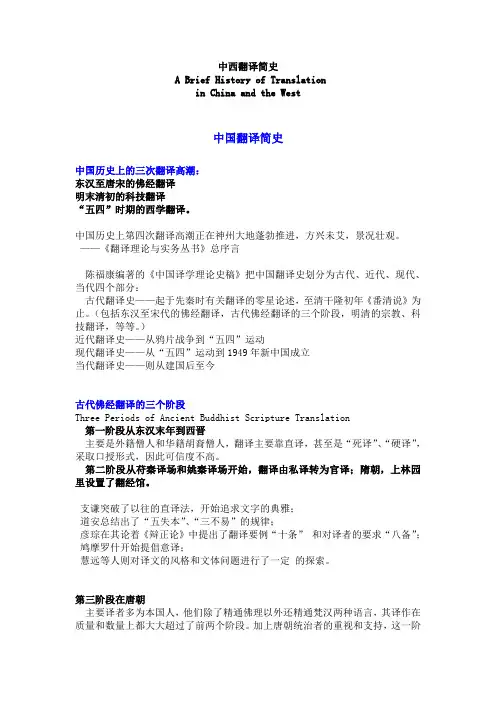
中西翻译简史A Brief History of Translationin China and the West中国翻译简史中国历史上的三次翻译高潮:东汉至唐宋的佛经翻译明末清初的科技翻译“五四”时期的西学翻译。
中国历史上第四次翻译高潮正在神州大地蓬勃推进,方兴未艾,景况壮观。
——《翻译理论与实务丛书》总序言陈福康编著的《中国译学理论史稿》把中国翻译史划分为古代、近代、现代、当代四个部分:古代翻译史——起于先秦时有关翻译的零星论述,至清干隆初年《番清说》为止。
(包括东汉至宋代的佛经翻译,古代佛经翻译的三个阶段,明清的宗教、科技翻译,等等。
)近代翻译史——从鸦片战争到“五四”运动现代翻译史——从“五四”运动到1949年新中国成立当代翻译史——则从建国后至今古代佛经翻译的三个阶段Three Periods of Ancient Buddhist Scripture Translation第一阶段从东汉末年到西晋主要是外籍僧人和华籍胡裔僧人,翻译主要靠直译,甚至是“死译”、“硬译”,采取口授形式,因此可信度不高。
第二阶段从苻秦译场和姚秦译场开始,翻译由私译转为官译;隋朝,上林园里设置了翻经馆。
支谦突破了以往的直译法,开始追求文字的典雅;道安总结出了“五失本”、“三不易”的规律;彦琮在其论着《辩正论》中提出了翻译要例“十条”和对译者的要求“八备”;鸠摩罗什开始提倡意译;慧远等人则对译文的风格和文体问题进行了一定的探索。
第三阶段在唐朝主要译者多为本国人,他们除了精通佛理以外还精通梵汉两种语言,其译作在质量和数量上都大大超过了前两个阶段。
加上唐朝统治者的重视和支持,这一阶段的译经活动达到顶峰,出现了玄奘、不空、义净等著名的僧人译经家。
玄奘提出了佛经翻译中著名的“五不翻”的原则,并为译经者进行了十一种详细的分工。
玄奘(602年-664年),唐代著名三藏法师,僧人,佛教学者、旅行家、佛经翻译家,唯识宗的创始者之一。
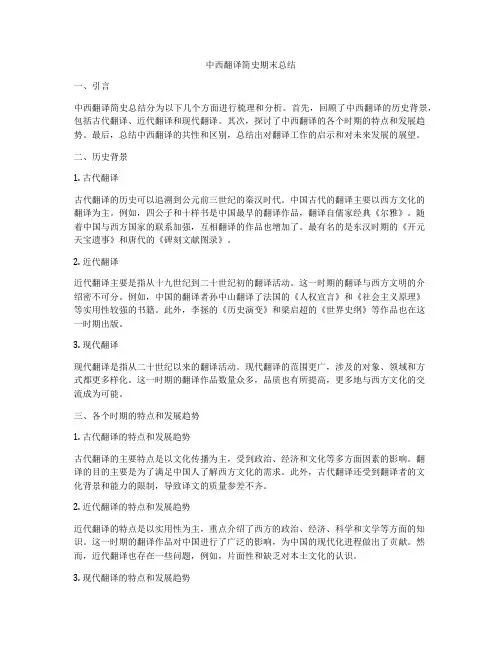
中西翻译简史期末总结一、引言中西翻译简史总结分为以下几个方面进行梳理和分析。
首先,回顾了中西翻译的历史背景,包括古代翻译、近代翻译和现代翻译。
其次,探讨了中西翻译的各个时期的特点和发展趋势。
最后,总结中西翻译的共性和区别,总结出对翻译工作的启示和对未来发展的展望。
二、历史背景1. 古代翻译古代翻译的历史可以追溯到公元前三世纪的秦汉时代。
中国古代的翻译主要以西方文化的翻译为主。
例如,四公子和十样书是中国最早的翻译作品,翻译自儒家经典《尔雅》。
随着中国与西方国家的联系加强,互相翻译的作品也增加了。
最有名的是东汉时期的《开元天宝遗事》和唐代的《碑刻文献图录》。
2. 近代翻译近代翻译主要是指从十九世纪到二十世纪初的翻译活动。
这一时期的翻译与西方文明的介绍密不可分。
例如,中国的翻译者孙中山翻译了法国的《人权宣言》和《社会主义原理》等实用性较强的书籍。
此外,李拯的《历史演变》和梁启超的《世界史纲》等作品也在这一时期出版。
3. 现代翻译现代翻译是指从二十世纪以来的翻译活动。
现代翻译的范围更广,涉及的对象、领域和方式都更多样化。
这一时期的翻译作品数量众多,品质也有所提高,更多地与西方文化的交流成为可能。
三、各个时期的特点和发展趋势1. 古代翻译的特点和发展趋势古代翻译的主要特点是以文化传播为主,受到政治、经济和文化等多方面因素的影响。
翻译的目的主要是为了满足中国人了解西方文化的需求。
此外,古代翻译还受到翻译者的文化背景和能力的限制,导致译文的质量参差不齐。
2. 近代翻译的特点和发展趋势近代翻译的特点是以实用性为主,重点介绍了西方的政治、经济、科学和文学等方面的知识。
这一时期的翻译作品对中国进行了广泛的影响,为中国的现代化进程做出了贡献。
然而,近代翻译也存在一些问题,例如,片面性和缺乏对本土文化的认识。
3. 现代翻译的特点和发展趋势现代翻译的特点是广泛和多样化。
现代翻译的范围涉及的领域更广泛,包括了政治、经济、科学、文化等多个方面。


翻译史复习重点依据历史上主流翻译对象的变化,中西翻译发展史可被划分为几个不同的阶段?一,宗教文献为主要翻译对象的宗教翻译阶段,宗教典籍翻译开启了中西翻译史的帷幕。
二,经典名著为主要翻译对象的文学翻译阶段,文学翻译丰富、深化了对翻译的认识。
三,实用文献为主要翻译对象的非文学翻译阶段,非文学翻译带来了翻译的职业化时代。
中国古代佛经的翻译历史,大致可分为几个时期?每个阶段的特点分别是什么?P45~531.东汉末年和三国时期:此时翻译阶段为佛经翻译的初期,译者没有原本,全凭外来僧人“以口授相付,不听载文“。
译者多为中亚和中国新疆的僧人,此时的翻译方法为集体翻译,称为”译场”包括三部分:口译(传言)记录(笔受)检验(证义)。
此时多采用直译法。
2.两晋和南北朝时期:此时由于统治者对佛教的逐渐接受,佛经翻译事业有了很大的发展。
逐渐脱离了私人的小规模翻译,变为大规模的译场,由私译转为官译,由个人翻译转为大规模的集体翻译。
佛经翻译采用传译和讲习相结合的方法。
由于译出的经典不断增加,佛经的目录整理应运而生。
总体来说,翻译理论和技巧在这一时期得到初步的总结与整理。
道安总结出“五失本,三不易”的佛经规律。
彦宗提出“八备说”,鸠摩罗什主张“依实出华”。
译文质量较前一阶段有多提高。
此时多采用意译。
3.隋唐北宋时期:此时的翻译活动与之前有明显不同,译场较大程度缩小规模,译场在参加人员方面极为挑剔,只有具备特殊能力的僧人或世俗官员才能参加,除工作人员,其它人禁止入内。
各职司分工明确,各司其职。
为培养新一代译者,各地僧院设立翻译学校。
然而佛教在印度的衰落导致中国佛经翻译活动从公元11世纪迅速衰落,译场时代随之结束。
佛经翻译对中国的文化和语言有哪些影响?P56~571.印度语支的文本给中文带来大量陌生的语言形式:名词三个数格和三个人称的复杂语法结构,过去时和现在时等。
2.影响宋明理学,在很大程度上受佛教的激发。
3.佛教理论武装当时学术名流的思想,研究佛学蔚然成风。


中西翻译简史课后习题部分答案Standardization of sany group #QS8QHH-HHGX8Q8-GNHHJ8-HHMHGN#中西翻译简史第7、9、11章课后习题部分答案中国古代重要的科技翻译作品有哪些有何特点天文、历法、数学、医学等,中国古代的科技翻译始于东汉末年,不过与翻译佛经的”译场“不同,这些翻译往往由译僧独自完成,所译内容也比较零散,是佛经翻译的附属或附产品,而非系统的介绍。
我国清末民初的科技翻译有哪些特点对我国的科学和文化发展有何作用此阶段是从19世纪开始,西方科技知识在中国广泛传播,并对中国的只是分子产生了普遍影响。
此时的各人文学科渐渐自成体系,而此时社会腐败,仅有少数有识之士注意到西学的优越之处,但仍不把它作为与中学对等的学术文化,其地位远不及中国的学术思想。
鸦片战争战败及一系列不平等条约的签订,激起思想先进者向西方学习的欲望,以达到“维新”之目的。
这就促成了西方科学技术再一次传入中国。
P118清末译出的科学书籍的知识就内容而言,清末译出的书籍比较浅显。
数量上看,清末73年约2100种,而民国时期译出的有10700种左右,五四后,科技译着的数量是清末的十倍。
且质量较高。
林则徐设立译馆,翻译西方书刊报纸,积极搜集西方信息。
译出了中国第一部系统介绍世界历史,地理类知识的《四洲志》。
它是当时介绍最齐备,最新颖的世界地理,历史,风土人情的图书。
魏源在《海国图志》中大量介绍外国自然,地理,经济,科学,文化等方面的资料。
徐继畲通过采访来华传教士,商人等编着了《灜环志略》,第一本中国人全面介绍世界地理的书籍。
虽然他们不通外语,但是较早重视并组织翻译外国资料,为同时代的人了解外部世界做出了贡献。
梁启超等一批富有世界眼光的思想家向西方学习大量的自然科学和社会科学的知识,政治上也强烈要求改革。
此时的大量西方知识,也产生了广泛而深刻的影响。
各类翻译出版机构也先后翻译出版了大量科学技术文献和教科书。
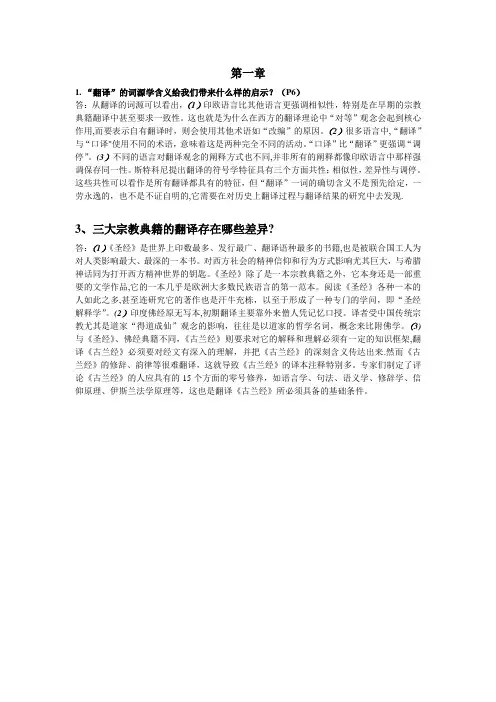
1.“翻译”的词源学含义给我们带来什么样的启示?(P6)答:从翻译的词源可以看出,(1)印欧语言比其他语言更强调相似性,特别是在早期的宗教典籍翻译中甚至要求一致性。
这也就是为什么在西方的翻译理论中“对等”观念会起到核心作用,而要表示自有翻译时,则会使用其他术语如“改编”的原因。
(2)很多语言中,“翻译”与“口译"使用不同的术语,意味着这是两种完全不同的活动。
“口译”比“翻译”更强调“调停”。
(3)不同的语言对翻译观念的阐释方式也不同,并非所有的阐释都像印欧语言中那样强调保存同一性。
斯特科尼提出翻译的符号学特征具有三个方面共性:相似性,差异性与调停。
这些共性可以看作是所有翻译都具有的特征,但“翻译”一词的确切含义不是预先给定,一劳永逸的,也不是不证自明的,它需要在对历史上翻译过程与翻译结果的研究中去发现.3、三大宗教典籍的翻译存在哪些差异?答:(1)《圣经》是世界上印数最多、发行最广、翻译语种最多的书籍,也是被联合国工人为对人类影响最大、最深的一本书。
对西方社会的精神信仰和行为方式影响尤其巨大,与希腊神话同为打开西方精神世界的钥匙。
《圣经》除了是一本宗教典籍之外,它本身还是一部重要的文学作品,它的一本几乎是欧洲大多数民族语言的第一范本。
阅读《圣经》各种一本的人如此之多,甚至连研究它的著作也是汗牛充栋,以至于形成了一种专门的学问,即“圣经解释学”。
(2)印度佛经原无写本,初期翻译主要靠外来僧人凭记忆口授。
译者受中国传统宗教尤其是道家“得道成仙”观念的影响,往往是以道家的哲学名词,概念来比附佛学。
(3)与《圣经》、佛经典籍不同,《古兰经》则要求对它的解释和理解必须有一定的知识框架,翻译《古兰经》必须要对经文有深入的理解,并把《古兰经》的深刻含义传达出来.然而《古兰经》的修辞、韵律等很难翻译,这就导致《古兰经》的译本注释特别多。
专家们制定了评论《古兰经》的人应具有的15个方面的零号修养,如语言学、句法、语义学、修辞学、信仰原理、伊斯兰法学原理等,这也是翻译《古兰经》所必须具备的基础条件。
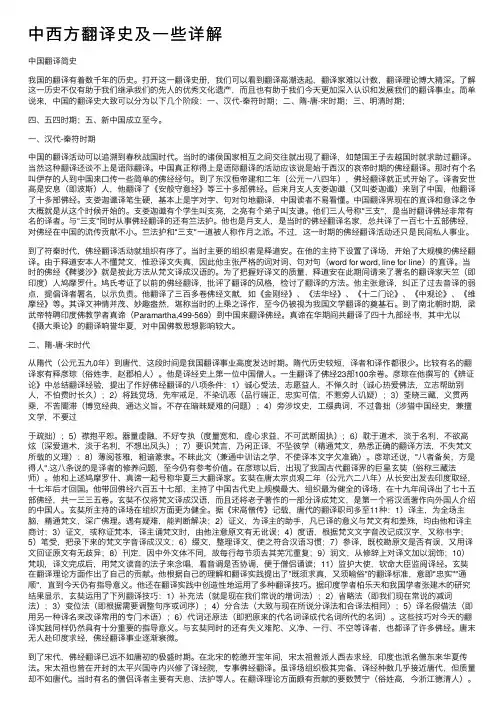
中西⽅翻译史及⼀些详解中国翻译简史我国的翻译有着数千年的历史。
打开这⼀翻译史册,我们可以看到翻译⾼潮迭起,翻译家难以计数,翻译理论博⼤精深。
了解这⼀历史不仅有助于我们继承我们的先⼈的优秀⽂化遗产,⽽且也有助于我们今天更加深⼊认识和发展我们的翻译事业。
简单说来,中国的翻译史⼤致可以分为以下⼏个阶段:⼀、汉代-秦符时期;⼆、隋-唐-宋时期;三、明清时期;四、五四时期;五、新中国成⽴⾄今。
⼀、汉代-秦符时期中国的翻译活动可以追溯到春秋战国时代。
当时的诸侯国家相互之间交往就出现了翻译,如楚国王⼦去越国时就求助过翻译。
当然这种翻译还谈不上是语际翻译。
中国真正称得上是语际翻译的活动应该说是始于西汉的哀帝时期的佛经翻译。
那时有个名叫伊存的⼈到中国来⼝传⼀些简单的佛经经句。
到了东汉桓帝建和⼆年(公元⼀⼋四年),佛经翻译就正式开始了。
译者安世⾼是安息(即波斯)⼈,他翻译了《安般守意经》等三⼗多部佛经。
后来⽉⽀⼈⽀娄迦谶(⼜叫娄迦谶)来到了中国,他翻译了⼗多部佛经。
⽀娄迦谶译笔⽣硬,基本上是字对字、句对句地翻译,中国读者不易看懂。
中国翻译界现在的直译和意译之争⼤概就是从这个时候开始的。
⽀娄迦谶有个学⽣叫⽀亮,之亮有个弟⼦叫⽀谦。
他们三⼈号称"三⽀",是当时翻译佛经⾮常有名的译者。
与"三⽀"同时从事佛经翻译的还有竺法护。
他也是⽉⽀⼈,是当时的佛经翻译名家,总共译了⼀百七⼗五部佛经,对佛经在中国的流传贡献不⼩。
竺法护和"三⽀"⼀道被⼈称作⽉之派。
不过,这⼀时期的佛经翻译活动还只是民间私⼈事业。
到了符秦时代,佛经翻译活动就组织有序了。
当时主要的组织者是释道安。
在他的主持下设置了译场,开始了⼤规模的佛经翻译。
由于释道安本⼈不懂梵⽂,惟恐译⽂失真,因此他主张严格的词对词、句对句(word for word, line for line)的直译。
当时的佛经《鞞婆沙》就是按此⽅法从梵⽂译成汉语的。
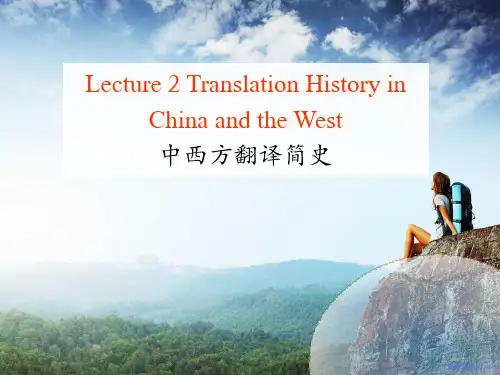
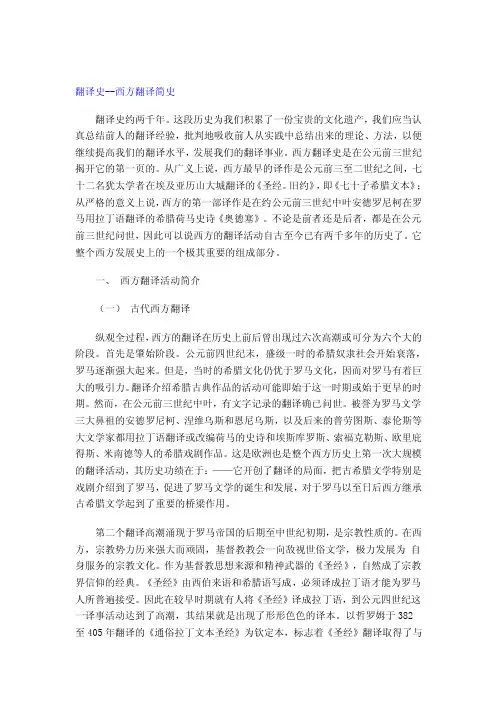
翻译史--西方翻译简史翻译史约两千年。
这段历史为我们积累了一份宝贵的文化遗产,我们应当认真总结前人的翻译经验,批判地吸收前人从实践中总结出来的理论、方法,以便继续提高我们的翻译水平,发展我们的翻译事业。
西方翻译史是在公元前三世纪揭开它的第一页的。
从广义上说,西方最早的译作是公元前三至二世纪之间,七十二名犹太学者在埃及亚历山大城翻译的《圣经。
旧约》,即《七十子希腊文本》;从严格的意义上说,西方的第一部译作是在约公元前三世纪中叶安德罗尼柯在罗马用拉丁语翻译的希腊荷马史诗《奥德塞》。
不论是前者还是后者,都是在公元前三世纪问世,因此可以说西方的翻译活动自古至今已有两千多年的历史了。
它整个西方发展史上的一个极其重要的组成部分。
一、西方翻译活动简介(一)古代西方翻译纵观全过程,西方的翻译在历史上前后曾出现过六次高潮或可分为六个大的阶段。
首先是肇始阶段。
公元前四世纪末,盛级一时的希腊奴隶社会开始衰落,罗马逐渐强大起来。
但是,当时的希腊文化仍优于罗马文化,因而对罗马有着巨大的吸引力。
翻译介绍希腊古典作品的活动可能即始于这一时期或始于更早的时期。
然而,在公元前三世纪中叶,有文字记录的翻译确已问世。
被誉为罗马文学三大鼻祖的安德罗尼柯、涅维乌斯和恩尼乌斯,以及后来的普劳图斯、泰伦斯等大文学家都用拉丁语翻译或改编荷马的史诗和埃斯库罗斯、索福克勒斯、欧里庇得斯、米南德等人的希腊戏剧作品。
这是欧洲也是整个西方历史上第一次大规模的翻译活动,其历史功绩在于:——它开创了翻译的局面,把古希腊文学特别是戏剧介绍到了罗马,促进了罗马文学的诞生和发展,对于罗马以至日后西方继承古希腊文学起到了重要的桥梁作用。
第二个翻译高潮涌现于罗马帝国的后期至中世纪初期,是宗教性质的。
在西方,宗教势力历来强大而顽固,基督教教会一向敌视世俗文学,极力发展为自身服务的宗教文化。
作为基督教思想来源和精神武器的《圣经》,自然成了宗教界信仰的经典。
《圣经》由西伯来语和希腊语写成,必须译成拉丁语才能为罗马人所普遍接受。
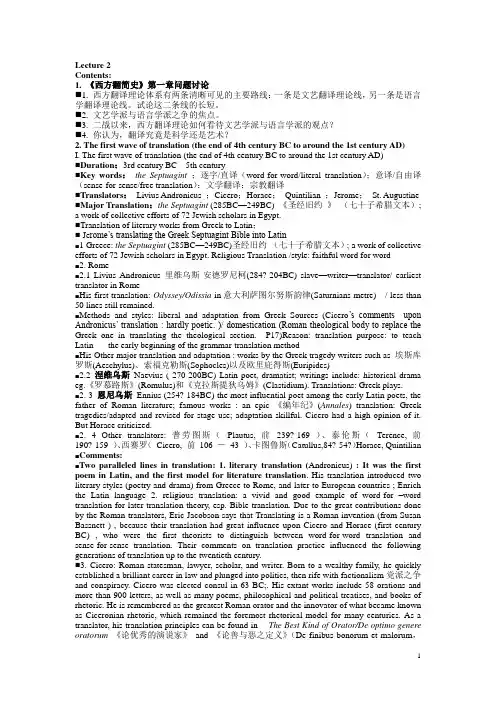
Lecture 2Contents:1. 《西方翻简史》第一章问题讨论⏹1. 西方翻译理论体系有两条清晰可见的主要路线:一条是文艺翻译理论线,另一条是语言学翻译理论线。
试论这二条线的长短。
⏹2. 文艺学派与语言学派之争的焦点。
⏹3. 二战以来,西方翻译理论如何看待文艺学派与语言学派的观点?⏹4. 你认为,翻译究竟是科学还是艺术?2. The first wave of translation (the end of 4th century BC to around the 1st century AD)I. The first wave of translation (the end of 4th century BC to around the 1st century AD)⏹Duration:3rd century BC---5th century⏹Key words:the Septuagint ;逐字/直译(word-for-word/literal translation);意译/自由译(sense-for-sense/free translation);文学翻译;宗教翻译⏹Translators:Livius Andronicus ;Cicero;Horace;Quintilian ;Jerome;St. Augustine⏹Major Translation:the Septuagint (285BC—249BC) 《圣经旧约》(七十子希腊文本);a work of collective efforts of 72 Jewish scholars in Egypt.⏹Translation of literary works from Greek to Latin;⏹ Je rome’s translating the Greek Septuagint Bible into Latin⏹1 Greece: the Septuagint (285BC—249BC)圣经旧约(七十子希腊文本); a work of collective efforts of 72 Jewish scholars in Egypt. Religious Translation /style: faithful word for word⏹2. Rome⏹2.1 Livius Andronicus 里维乌斯·安德罗尼柯(284?-204BC) slave—writer—translator/ earliest translator in Rome⏹His first translation: Odyssey/Odissia in意大利萨图尔努斯韵律(Saturnians metre) / less than50 lines still remained.⏹Methods and styles: liberal and adaptation from Greek Sources (Cicero’s comments upon Andronicus’ translation : hardly poetic. )/ domestication (Roman theological body to replace the Greek one in translating the theological section. P17)Reason: translation purpose: to teach Latin-----the early beginning of the grammar-translation method⏹His Other major translation and adaptation : works by the Greek tragedy writers such as 埃斯库罗斯(Aeschylus)、索福克勒斯(Sophocles)以及欧里庇得斯(Euripides)⏹2.2 涅维乌斯Naevius ( 270-200BC) Latin poet, dramatist; writings include: historical drama eg.《罗慕路斯》(Romulus)和《克拉斯提狄乌姆》(Clastidium). Translations: Greek plays.⏹2. 3 恩尼乌斯Ennius (254?-184BC) the most influential poet among the early Latin poets, the father of Roman literature; famous works : an epic 《编年纪》(Annales) translation: Greek tragedies/adapted and revised for stage use; adaptation skillful. Cicero had a high opinion of it. But Horace criticized.⏹2. 4 Other translators: 普劳图斯(Plautus, 前239?-169 )、泰伦斯(Terence, 前190?-159 )、西赛罗(Cicero, 前106 -43 )、卡图鲁斯(Catullus,84?-54?)Horace, Quintilian ⏹Comments:⏹Two paralleled lines in translation: 1. literary translation (Andronicus): It was the first poem in Latin, and the first model for literature translation. His translation introduced two literary styles (poetry and drama) from Greece to Rome, and later to European countries ; Enrich the Latin language 2. religious translation: a vivid and good example of word-for –word translation for later translation theory, esp. Bible translation. Due to the great contributions done by the Roman translators, Eric Jacobson says that Translating is a Roman invention (from Susan Bassnett ) , because their translation had great influence upon Cicero and Horace (first century BC) , who were the first theorists to distinguish between word-for-word translation and sense-for-sense translation. Their comments on translation practice influenced the following generations of translation up to the twentieth century.⏹3. Cicero: Roman statesman, lawyer, scholar, and writer. Born to a wealthy family, he quickly established a brilliant career in law and plunged into politics, then rife with factionalism党派之争and conspiracy. Cicero was elected consul in 63 BC;. His extant works include 58 orations and more than 900 letters, as well as many poems, philosophical and political treatises, and books of rhetoric. He is remembered as the greatest Roman orator and the innovator of what became known as Ciceronian rhetoric, which remained the foremost rhetorical model for many centuries. As a translator, his translation principles can be found in The Best Kind of Orator/De optimo genere oratorum《论优秀的演说家》and 《论善与恶之定义》(De finibus bonorum et malorum,45-44BC). In Orator, he made two major points; that word-for-word translation is not suitable; and that translators should seek in their own language expressions that reproduce as much as possible the cogency of the original.Cicero thus commented upon his methods in translating Aeschines and Demosthenes’ speeched And I did not translate them as an interpreter, but as an orator, keeping the same ideas and forms, or as one might say, the ‘figures’ of thought, but in lang uage which conforms to our usage. And in so doing, I did not hold it necessary to render word for word, but I preserved the general style and force of the language.我不是作为解释者,而是作为演说家来进行翻译的,保留相同的思想和形式,或者如人所说的,保留思维的‘影子/形象’,但要以符合我们语言的用法为准。
中西翻译简史期末总结
《中西翻译简史》是一本介绍中西翻译发展历史的著作,它帮助我们了解了中西翻译
交流的起源、演变和影响。
期末总结可以围绕以下几个方面展开:
1. 历史背景:总结中西翻译发展过程中的关键历史事件和背景,如东汉时期的“通变”翻译活动、13世纪的西学东渐、16世纪的文艺复兴等,这些背景对中西翻译的影响非常深远。
2. 主要翻译流派:总结不同历史时期出现的主要翻译流派及其特点,如汉学翻译、词
汇翻译、文学翻译、社会科学翻译等,它们分别在不同领域和时期起到了重要作用。
3. 主要翻译家和作品:总结中西翻译史上的著名翻译家及其主要作品,如严复的《西
学演义》,林则徐的《天朝田亩制度》,鲁迅的《叔本华选集》等。
分析这些翻译家
和作品的贡献,可以更好地理解他们所处时代的思想和文化。
4. 影响和启示:总结中西翻译发展对于两个文化的交流和影响。
可以分析中西翻译史
对于中西方文化融合的推动作用,以及中西翻译活动对于思想、学术、经济、政治等
方面的影响。
总结时需要注意结合具体事例和论据进行分析和说明,突出中西翻译发展的重要节点,挖掘其中的规律和特点,并对其影响和启示进行深入思考和探讨。
《中西翻译简史》述评《中国翻译简史》是由谢天振等人共同编纂的一部有关中西方翻译史的著作。
它是由外语教学与研究出版社于2009年10月第一次出版,是全国翻译硕士专业学位系列教材之一。
本文作者之所以选此文本,是因为在与其它同类著作进行对比后发现,所有文本都只是单方面地谈论中国或者西方的翻译发展史,而只有《中西方翻译简史》是将两种不同文化的翻译发展史以平行式的结构呈现。
因此,本文作者认为将它们进行对比学习,成果会更加突出。
一、内容简介在第一章中,作者首先指出翻译的作用和意义,提出翻译研究的必要性,进而说明翻译史对翻译研究的作用,更新对翻译的观念。
第二章提出作者以历史上主流翻译对象的变化为依据,将中西方翻译史分为三个不同的阶段,即宗教翻译阶段、文学翻译阶段和非文学翻译。
从第三章至第十三章这十二章的内容以平行交互式结构进行论述。
第三、四、五章回顾了中西方宗教典籍的翻译。
第三章讲述中国的佛教典籍在东汉末年和三国时期、南北朝时期以及隋唐北宋时期三个阶段的翻译活动。
第四章主要讲述早期圣经翻译与基督教的传播及其权威地位的建立;宗教改革和圣经翻译以及圣经译本随时代的需要不断涌现。
第五章梳理了圣经中译的发展,包括不同时期翻译特点、译名之争、圣经的官话和合译本三项内容。
第六章和第七章分别探讨了中国和西方在不同时期的的科技文献翻译。
第六章首先论述了古希腊毕达哥拉斯、柏拉图等人的翻译对西方科学的发展产生了重大影响。
然后提到中世纪巴格达翻译中心对阿拉伯文献的翻译成为文艺复兴运动发生的重要因素。
第九章主要提及明末清初徐光启等人和意大利的利玛窦通过翻译将西方科学技术传入我国。
此外,清末民初洋务派和五四运动时期的一些进步知识分子对中国的科技发展产生了重大影响。
第八章和第九章分别阐述翻译对近代欧洲各国民族语形成的影响以及对中国文化的影响。
第八章首先提出翻译对英语发展的影响;其次,德语的发展受拉丁语和许多欧洲语言的影响。
一些欧洲民族语,如意大利语、西班牙语、法语等的形成和发展多受拉丁语的影响。
(完整word版)中西翻译简史第12、14章课后习题部分答案编辑整理:尊敬的读者朋友们:这里是精品文档编辑中心,本文档内容是由我和我的同事精心编辑整理后发布的,发布之前我们对文中内容进行仔细校对,但是难免会有疏漏的地方,但是任然希望((完整word版)中西翻译简史第12、14章课后习题部分答案)的内容能够给您的工作和学习带来便利。
同时也真诚的希望收到您的建议和反馈,这将是我们进步的源泉,前进的动力。
本文可编辑可修改,如果觉得对您有帮助请收藏以便随时查阅,最后祝您生活愉快业绩进步,以下为(完整word版)中西翻译简史第12、14章课后习题部分答案的全部内容。
第十二章1、西方各国对中国文化典籍的翻译大致分为哪几个阶段?每个阶段的主要翻译对象和翻译特点是什么?1、18世纪以前,法国是汉学研究中心,主要的翻译对象是儒家经典。
特点法国的汉学研究和汉籍翻译的发达和普及程度很高。
1876年法兰西学院还专门设立了儒莲国际汉籍翻译奖,用以表彰为汉籍外译作出杰出贡献的各国翻译家.2、19世纪在华殖民圈对中国文化典籍的翻译。
注重实用主义,儒家经典翻译更系统,更倾向于学术研究。
3、20世纪上半页,儒家经典翻译走向欧美,融入欧美文化,文学形式多种多样,有诗歌,散文等。
4、20世纪下半页,儒家经典翻译全译本多,汉语热逐渐慢下来,只有专家还在从事此方面的翻译。
3、试分析理雅各对儒家著作翻译的主要成就以及亚瑟韦利对儒家著作翻译的主要特点?自1843年起,19世纪最著名的英国汉学家理雅各开始主持《中国经典》的翻译工作,涉及儒家经典九种和道家经典2种,并各自附以原文、注释、结论撰写到出版均成体系,并安排多人参与助译。
1861年,“四书"译本依序字香港出版,为中国经典一、二卷。
在此后二十五年间,他陆续翻译出版了中国的《论语》,《大学》,《中庸》,《孟子》,《春秋》,《礼记》,《书经》,《孝经》,《易经》,《诗经》等儒家经典。
中西翻译简史20111020问题整合1.形合和意合答:英语注重形合(hypotaxis),汉语注重意合(parataxis)。
2.主题显示和主语显示答:汉语句子逻辑性强,主题突出;英语句子结构严谨,主语突出。
3.The definition of Grammar答:In linguistics, grammar is the set of structural rules that govern the composition of clauses, phrases, and words in any given natural language. The term refers also to the study of such rules, and this field includes morphology, syntax, and phonology, often complemented by phonetics, semantics, and pragmatics. Linguists do not normally use the term to refer to orthographical rules, although usage books and style guides that call themselves grammars may also refer to spelling and punctuation.The term "grammar" is often used by non-linguists with a very broad meaning indeed; as Jeremy Butterfield puts it: "Grammar is often a generic way of referring to any aspect of English that people object to." However, linguists use it in a much more specific sense. Every speaker of a language has, in his or her head, a set of rules for using that language. This is a grammar, and—at least in the case of one's native language—the vast majority of the information in it is acquired not by conscious study or instruction, but by observing other speakers; much of this work is done during infancy. Language learning later in life, of course, may involve a greater degree of explicit instruction.The term "grammar" can also be used to describe the rules that govern the linguistic behavior of a group of speakers. The term "English grammar", therefore, may have several meanings. It may refer to the whole of English grammar—that is, to the grammars of all the speakers of the language—in which case, the term encompasses a great deal of variation.Alternatively, it may refer only to what is common to the grammars of all, or of the vast majority of, English speakers (such as subject–verb–object word order in simple declarative sentences). Or it may refer to the rules of a particular, relatively well-defined variety of English (such as Standard English).4.词汇语法化(lexical grammaticalization)答:语法化主要研究词汇成分到语法成分的演变,涉及词义的虚化和语法作用的增强两个方面。
词语的演变从意义上说是从实到虚,从功能上说是语法作用更加地突出。
语法化理论为我们提供了理解语言演化的新视野,使我们能够对很多语法现象的来源作出简单、合理而且一致的解释。
5.The sources of idioms and the types of idioms答:The idioms come from myth, everyday life, historical events, environment, religion, military events, literary works, allusion, etc.谚语的分类:(一)溯其由来可分为1). 在长期的社会实践中总结出来的朴素道理、普遍常识或经验教训。
如:Well begun is half done.良好的开端是成功的一半。
Pride goes before a fall.骄傲使人落后。
2). 从神话寓言、莎士比亚剧作、《圣经》故事等经典著作中流传下来的格言、名录。
如:The tree is known by its fruits.(Bible. Matthew)观其果而知其树,观其行而知其人。
(《圣经﹒马太福音》)Too swift arrives as tardy as too slow.(Shakespear‖Romeo and Julie‖)欲速则不达。
(莎士比亚《罗密欧与朱丽叶》)(二)根据谚语的思想内容又可分为:1). 思想真理。
如:All that glisters is not gold.发亮的东西未必都是金子、Every cloud has a silver lining.黑夜慢慢终有尽头。
2). 道德爱憎。
如:Handsome is that handsome does. 行为美才是真正美。
3). 友谊力量。
如:Unity is power. 团结就是力量A friend in need is a friend indeed. 患难朋友才是真正朋友。
4). 实践经验。
如:Practice makes perfect.熟能生巧。
Rome is not build in a day. 冰冻三尺,非一日之寒。
5). 时间节气。
如:Tide waits for no man.时光不等人。
The lose is never found again.光阴一去不复返。
6). 学习意志。
如:It is never too old to learn,活到老,学到老。
Jack of all trades is a master of none.行行都懂点,行行都不精通。
----张毓彪,―英语谚语的分类与翻译‖,《成都教育学院学报》,2005年6期,第76页。
6.严复翻译标准中的雅的意义?结合《天演论》,他采用的什么文体和翻译方法?答:雅:指译文时选用的词语要得体,追求文章本身的古雅,简明优雅。
《天演论》是严复根据英国生物学家赫胥黎(Thomas Henry Huxley)1894年发表的《进化论与伦理学》(Evolution and Ethics)编译的。
严复翻译时,并没有直译原文,而是在编译的基础上加入评论。
译文语言使用桐城派优美的骈文,译本读起来音节婉转,极富节奏美。
---摘自课本第150页~151页。
7.桐城派答:桐城派,即桐城文派,又称:桐城古文派、桐城散文派。
其主要代表人物戴名世、方苞、刘大櫆、姚鼐均系清代安徽桐城人(今桐城文化圈包括桐城市、枞阳县和安庆市宜秀区等部分地区),故名。
桐城文派是清代文坛最大散文流派,其作家多、播布地域广、绵延时间久,文学史所罕见。
桐城派的文章,内容多是宣传儒家思想,尤其是程朱理学;语言则力求简明达意,条理清晰,―清真雅正‖。
他们的许多散文都体现了这一特点。
主张学习左传、史记,讲究义法,提倡义理,要求语言雅洁,反对俚俗。
8.归化和异化答:Domestication and Foreignization.Domestication refers to the target-culture-oriented translation in which unusual expressions to the target culture are exploited and turned into some familiar ones so as to make the translated text intelligible and easy for the target readers.Foreignization is a source-culture-oriented translation which strives to preserve the foreign flavor as much as possible in order to transfer the source language and culture into the target one.9.鲁迅所说的“洋化”,是否承认了中国文化的弱势?答:我认为不是的。
鲁迅对译作的标准提出了自己的看法:即翻译是要从―信而不顺‖转到既―信‖又―顺‖的,是―归化‖与―洋化‖,即意译与直译相结合,从而既意译与直译相结合,从而既―保存原作的丰姿‖,又非常易解。
(常崇娟,常士昭,翻译标准化的认识。
《大众标准化》1998年第一期,第22页-第23页)鲁迅先生说到的:―取今复古,别立新宗‖,具体来说,就是把传统的和西方的文明中好的东西拿来,为我所用。
用两个字来概括,就是―通‖和―化‖,―通‖是指中西古今都要通,要充分了解;―化‖就是要吸收,成为自己的东西,转化为中国人自己的文化创造。